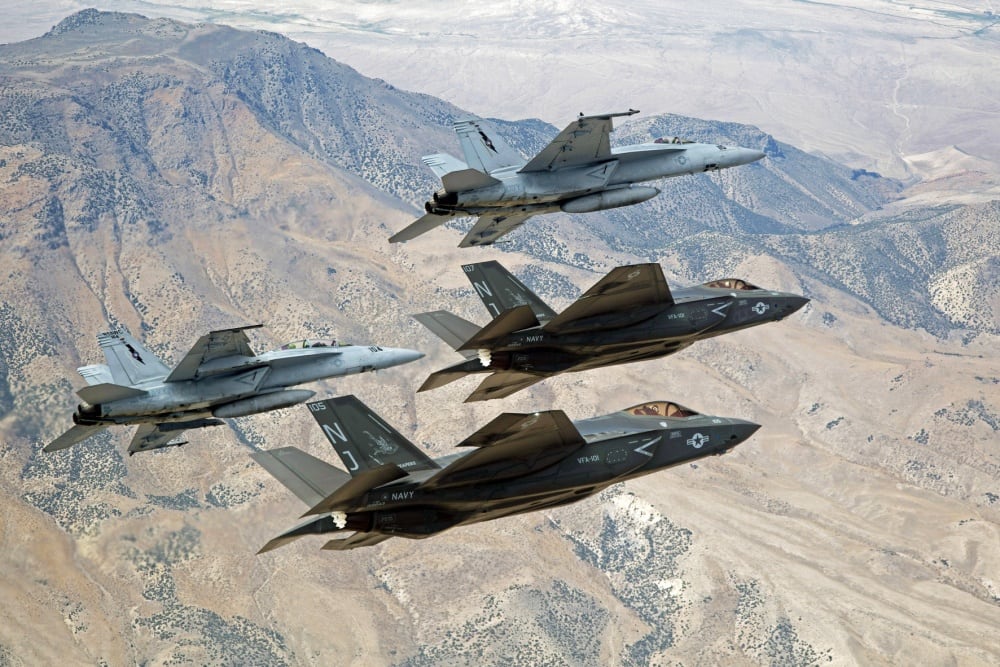Marine pilots training for missions in the Pacific don’t have adequate airspace and lack realistic electronic warfare threats, according to a new report.
And that’s not all.
These aviators don’t have moving targets, don’t have dedicated drone flight space and can’t use one of their most effective weapons at all before they first enter combat.
All of those findings and more from a recent government audit released to the public on April 17 led to one overarching conclusion: “Aviation units do not receive realistic training.”
The defense inspector general’s audit covered training ranges for the Army, Navy, Air Force and Marine Corps that are covered in the Indo-Pacific Command area of responsibility.
RELATED

One detail shows a direct connection to where these problems could hit pilots in combat.
A Harrier pilot told inspectors that there was not enough ordnance for training. Specifically, that the last time MAG-13 pilots had been able to use the joint direct attack munition, or JDAM, in training in March 2016.
“He stated that as a result, there was a good chance that Marines would arrive in a combat environment never having trained with the JDAM,” according to the report.
The same pilot added that the simulators used do not replicate the missile well and were not effective for realistic training.
Training problems for Marine pilots were not isolated to one location or one type of aircraft.
Aviators who fly the new F-35B jet fighter, the aging AV-8 Harrier, the AH-1 Cobra and even unmanned drones reported training troubles.
“We are proactively working with the Office of the Secretary of Defense to address training shortfalls at Marine Corps ranges, including Yuma, Ariz," Capt. Joseph Butterfield, Headquarters Marine Corps public affairs, wrote in an email response. “We are committed to addressing these issues as quickly as possible with available resources, aligning Marine Corps training improvements with DoD-wide solutions. No additional details are available at this time."
The report included Marine Aircraft Groups 24, 12, 36 and 13. Those are spread out from Marine Corps Air Station Yuma, Arizona, across the Pacific to Japan and South Korea.
At the Fallon Range Training Complex, a naval air station in Nevada, weapons and tactics instructors, some with multiple combat tours in Iraq and Afghanistan, told investigators that “airspace, release headings and impact areas” at the training site were “too restrictive to use the preferred standoff weapons that are required to defeat a near-peer threat.”
Aviators reported low fidelity electronic warfare training tools at FRTC, Yuma and the closest site for pilots in Okinawa to even train with the admittedly substandard EW tools was Iwakuni, on mainland Japan.
“Many of the ranges in our sample did not have the advanced electronic warfare systems needed to accurately replicate near-peer threats; therefore, training against electronic warfare systems at those ranges in our sample was not realistic,” inspectors wrote.
Even the surface-to-air threats at that range were dated, having been developed and fielded in the 1960s and 1970s, according to the report.
An F-35 pilot at Yuma also reported that airspace restrictions prevented pilots from shooting stand off weapons. Restrictions also meant he could not fly in a fighting formation of four planes at a time. Pilots had to use simulators to do such basic tasks.
The Yuma site also can’t replicate “double-digit threats,” a key to air battle training for modern competitors.
A direct example, the Russian Pantsir long-range air defense system, which includes truck mounted surface-to-air missiles, was listed as one such threat that Marine pilots cannot train for at Yuma.
Even rotary wing pilots said that Yuma urban training complexes were so standard that after one or two runs pilots training became predictable.
It “does not provide a realistic training environment for helicopter gunnery operations,” according to the report.
Drone operators noted that they did not have any dedicated airspace at Yuma, having to share the skies with manned aircraft, which limited what they were allowed to do in certain scenarios.
A Harrier pilot also shared that the aircraft’s main weapon, a laser-guided rocket, could not be used to hit moving targets at the site because of a lack of moving targets to shoot.
The targets are remote-operated vehicles that tow a target sled. The report did not define why those items were unavailable or missing from training.
Inspectors found that some of the problems were trends seen across the services and globe. Many of the existing ranges were developed for World War II or Korean War-ear aircraft and munitions. And since their construction urbanization, environmental constrictions and other concerns have limited what pilots can do on the ranges.
So, aircraft are generations ahead of the ranges they’re being used on.
And training staff at the sites are trying to find ways to move aircraft at different layers in restricted airspace to better provide realistic scenarios, according to the report.
The assistant secretary of defense for sustainment told inspectors upon receiving the audit that the Pentagon would develop “a strategic plan to identify and address inadequacies at training ranges.”
And that plan, the secretary wrote, “will be comprehensive and cover all operating domains.”
Inspectors traveled from February to May 2018 to sites on the West Coast, to include Arizona, California and Alaska and also visited locations in Japan, Hawaii and South Korea to evaluate how well the ranges met training standards for realistic combat preparation, especially near-peer competitors.
Todd South has written about crime, courts, government and the military for multiple publications since 2004 and was named a 2014 Pulitzer finalist for a co-written project on witness intimidation. Todd is a Marine veteran of the Iraq War.




